Google’s June 2025 Update: What Changed and How Law Firms Can Stay Ahead
Posted on Wednesday, July 23rd, 2025 at 1:51 am
A Targeted Refresh to Google’s Ranking System
Google has officially completed its June 2025 Core Update, targeting the precision, relevance, and authority used to select and rank content. Summed up, this update brought forth these changes via MUVERA and Graph Foundation Models.
Google’s official update was:
“This is a regular update designed to better surface relevant, satisfying content for searchers from all types of sites.”
This vague statement seems to be a rebalancing of content quality signals. Pages that demonstrate subject-matter clarity, authority, and purpose are starting to outperform those that rely on surface-level coverage or keyword stuffing. But what are “MUVERA” and “Graph Foundation Models?”
MUVERA: Google’s More Precise Retrieval Method
MUVERA is Google’s new retrieval algorithm built on multi-vector search using Fixed Dimensional Encodings. Way too technical for us to explain in a blog post, but essentially, it changes how Google selects how many and which pages to consider for ranking, improving both efficiency and precision. Instead of casting a wide net, MUVERA narrows the pool of candidate pages early in the process, focusing only on those that meet a high standard of relevance.
A visual from Google Research below shows an example of MUVERA’s fixed dimensional encoding generation. Notice how the search query “What is the height of Mount Everest?” is broken apart by categorizing each word to better understand what the user is asking – this categorization is then done on content from the internet to organize possible answers in the same format and ultimately connect the answer back to the question.

From an SEO standpoint, this matters because it changes what kind of content makes it into the running. Pages that lack clear signals of topic relevance or that drift from the user’s intent may never be evaluated for ranking at all. That puts more pressure on each page to demonstrate its usefulness from the start.
MUVERA also reduces the volume of web pages Google needs to scan while still delivering high recall. According to Google, it retrieves up to twenty times fewer pages to achieve the same quality of results. This efficiency allows more computing power to be spent on analyzing the most relevant pages in greater depth.
For law firms, this means that pages with thin content, broad targeting, or unclear purpose are more likely to be excluded early. On the other hand, pages that are tightly focused on specific legal topics, structured clearly, and written for real search intent now stand a better chance of being seen.
Graph Foundation Model: AI That Understands Relationships
Google’s Graph Foundation Model, or GFM, represents a major advancement in how search can interpret connections between content, links, users, and other data points. Unlike older systems that were limited to the specific graphs they were trained on, GFM can apply its understanding across entirely new structures without retraining. This flexibility opens the door to deeper context analysis across the web.
GFM works by classifying relationships between nodes and edges (i.e. documents, links, or even site visitors). It has already been tested in areas like ad spam detection, where it outperformed traditional methods by a wide margin. Google reported gains as high as forty times in average precision when GFM was applied over older systems.
The key takeaway is that Google is no longer looking at pages in isolation. It’s evaluating how they connect, both within a site and across the internet. That includes how practice area pages link to related blog posts, how consistently topics are addressed across a domain, and whether signals of trust and authority are backed by meaningful content.
For attorneys, this points to the growing importance of a cohesive content strategy. A site scattered with disconnected or duplicate content is likely to be seen as less trustworthy. In contrast, a site that builds clear relationships between topics, supports claims with citations, and maintains strong internal linking is now more likely to be interpreted as authoritative.
Behind the Ranking Changes
With MUVERA improving how Google selects which content to consider, and the Graph Foundation Model deepening how it evaluates relationships between those pages, the June 2025 update reflects a more advanced filtering and scoring process under the surface.
The practical effect is that Google’s systems are now better equipped to find content that closely matches the user’s intent while also recognizing which sites demonstrate authority through structure and consistency. Sites with loose topic alignment or weak interlinking may fall behind simply because they no longer fit the model of what quality content looks like.
This also means that tactics aimed at gaming the system with broad content, keyword stuffing, or link schemes have less influence. Google’s ranking algorithms are leaning more on signals tied to genuine expertise and thematic coherence.
In this environment, surface-level optimization matters less than having real substance behind every page. Content that answers specific legal questions, connects clearly to related topics, and reflects an understanding of the user’s purpose is more likely to gain visibility.
How Law Firms Can Respond
The June update raises the standard for what qualifies as relevant, rank-worthy content. Google’s systems are now more selective in what they retrieve and more thorough in how they assess relationships between pages. This creates a clear divide between firms with focused, intentional content strategies and those with outdated or scattershot publishing habits. In general, law firms with trustworthy SEO teams working on their websites should feel confident that their sites and rankings won’t be harmed – but for firms in extremely competitive markets, even “good enough” may not achieve a dominant position in their local SERPs.
TSEG builds every marketing strategy with these signals, and dominance in mind. Our team develops content that speaks directly to what prospective clients are searching for, structured in a way that aligns with how Google’s systems now evaluate authority and intent. Contact us today to see how we can help your law firm dominate your local search.
